KIA CARNIVAL 2007 Workshop Manual
Manufacturer: KIA, Model Year: 2007, Model line: CARNIVAL, Model: KIA CARNIVAL 2007Pages: 1575, PDF Size: 44.86 MB
Page 861 of 1575

General information
Page 862 of 1575
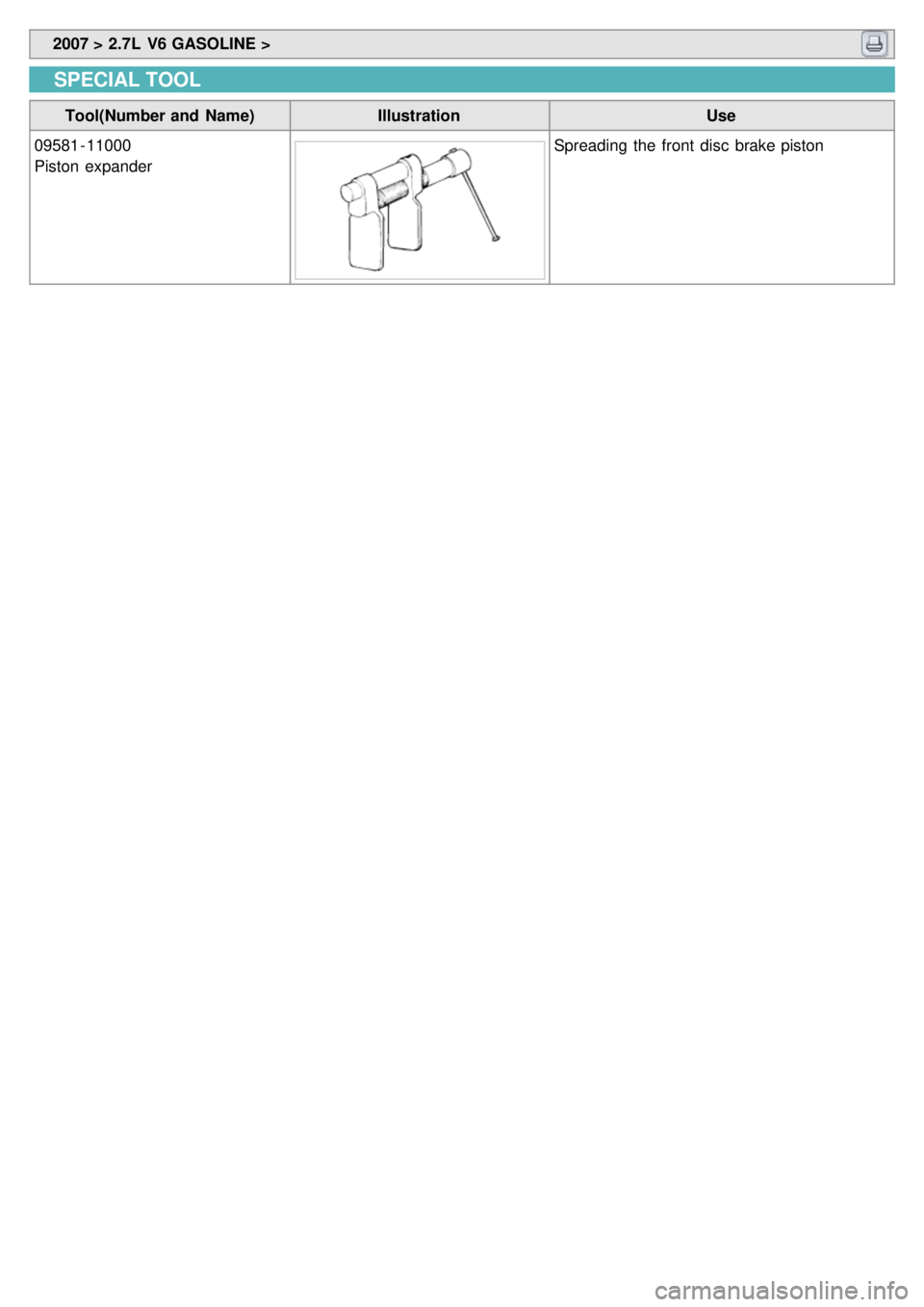
2007 > 2.7L V6 GASOLINE >
SPECIAL TOOL
Tool(Number and Name) Illustration Use
09581 - 11000
Piston expander
Spreading the front disc brake piston
Page 863 of 1575
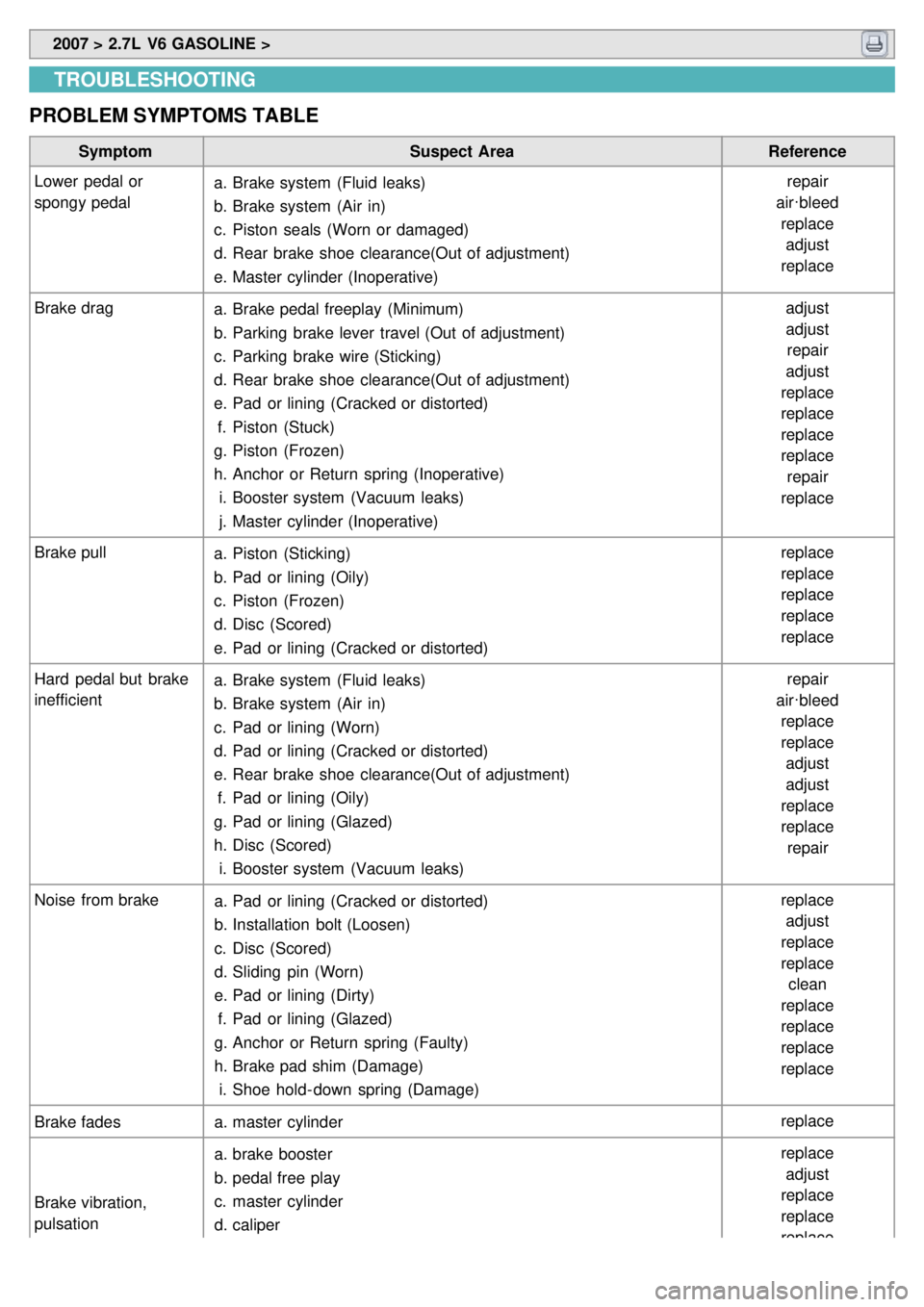
2007 > 2.7L V6 GASOLINE >
TROUBLESHOOTING
PROBLEM SYMPTOMS TABLE
Symptom Suspect Area Reference
Lower pedal or
spongy pedal a.
Brake system (Fluid leaks)
b. Brake system (Air in)
c. Piston seals (Worn or damaged)
d. Rear brake shoe clearance(Out of adjustment)
e. Master cylinder (Inoperative) repair
air·bleed replaceadjust
replace
Brake drag a.Brake pedal freeplay (Minimum)
b. Parking brake lever travel (Out of adjustment)
c. Parking brake wire (Sticking)
d. Rear brake shoe clearance(Out of adjustment)
e. Pad or lining (Cracked or distorted)
f. Piston (Stuck)
g. Piston (Frozen)
h. Anchor or Return spring (Inoperative)
i. Booster system (Vacuum leaks)
j. Master cylinder (Inoperative) adjust
adjust
repair
adjust
replace
replace
replace
replace repair
replace
Brake pull a.Piston (Sticking)
b. Pad or lining (Oily)
c. Piston (Frozen)
d. Disc (Scored)
e. Pad or lining (Cracked or distorted) replace
replace
replace
replace
replace
Hard pedal but brake
inefficient a.
Brake system (Fluid leaks)
b. Brake system (Air in)
c. Pad or lining (Worn)
d. Pad or lining (Cracked or distorted)
e. Rear brake shoe clearance(Out of adjustment)
f. Pad or lining (Oily)
g. Pad or lining (Glazed)
h. Disc (Scored)
i. Booster system (Vacuum leaks) repair
air·bleed replace
replaceadjust
adjust
replace
replace repair
Noise from brake a.Pad or lining (Cracked or distorted)
b. Installation bolt (Loosen)
c. Disc (Scored)
d. Sliding pin (Worn)
e. Pad or lining (Dirty)
f. Pad or lining (Glazed)
g. Anchor or Return spring (Faulty)
h. Brake pad shim (Damage)
i. Shoe hold- down spring (Damage) replace
adjust
replace
replace clean
replace
replace
replace
replace
Brake fades a.master cylinder replace
Brake vibration,
pulsation a.
brake booster
b. pedal free play
c. master cylinder
d. caliper replace
adjust
replace
replace
replace
Page 864 of 1575

e.master cylinder cap seal
f. damaged brake lines replace
replace
Brake Chatter Brake chatter is usually caused by loose or worn components, or
glazed or burnt linings. Rotors with hard spots can also contribute to
brake chatter. Additional causes of chatter are out - of- tolerance rotors,
brake lining not securely attached to the shoes, loose wheel bearings
and contaminated brake lining.
Page 865 of 1575

2007 > 2.7L V6 GASOLINE >
SPECIFICATIONS
Item Specification
Master cylinder
· Type
· I.D. mm(in)
· Piston stroke mm(in)
· Fluid level warning sensor Tandem type
26.99/(1.063)
30(1.18)
Provided
Brake booster
· Type
· Boosting ratio 8 + 9 in Tandem
9.0 : 1
Front brake(Disc)
· Type
· Disc O.D.
· Disc thickness
· Pad thickness
· Cylinder type
· Cylinder I.D. Floating type with ventilated disc
298 mm (11.73 in)
28 mm (1.10 in)
10.5 mm (0.41 in)
Double piston
Ø48 mm (Ø1.89 in)
Rear brake(Disc)
· Type
· Disc O.D.
· Disc thickness
· Pad thickness
· Cylinder type
· Cylinder I.D Floating type with solid disc
302 mm (11.89 in)
12 mm (0.47 in)
10 mm (0.39 in)
Single piston
Ø42.9 mm (Ø1.69 in)
Parking brake
· Type
· Actuation
· Drum DIH(Drum in hat)
Foot brake
Ø190 mm (Ø7.48 in)
O.D=Outer Diameter
I.D=Inner Diameter
ABS : Anti- lock Brake System
ESP : Electronic Stability Program
SERVICE STANDARD
Items Standard value
Brake pedal height 192.4 mm(7.57 in)
Brake pedal full stroke 122 mm (4.8 in)
Adjust Brake pedal full stroke 60 mm (2.36 in)
Brake pedal free play 3 ~ 8 mm(0.11 ~ 0.31 in)
Stop lamp switch outer case to pedal stopper clearance 1.0 ~ 1.5 mm (0.04 ~ 0.06 in)
Booster push rod to master cylinder piston clearance 0.6 ~ 1.7(0.02 ~ 0.07 in)(at 500 mmHg)
Parking brake pedal stroke when pedal assembly is depressed with
294N (30kgf, 66lb force) 145 mm (5.71 in) above
Front disc brake pad thickness 10.5 mm (0.41 in)
Front disc thickness 28 mm (1.10 in)
Rear disc brake pad thickness 10 mm (0.39 in)
Rear disc brake disc thickness 12 mm (0.47 in)
Rear parking brake liner thickness 4 mm (0.16 in)
Page 866 of 1575

TIGHTENING TORQUE
ItemsNmkgf.m lb - ft
Master cylinder to booster mounting nut 8 ~ 120.8 ~ 1.2 5.8 ~ 8.7
Brake booster mounting nut 13 ~ 161.3 ~ 1.6 9.4 ~ 11.6
Bleeder screw 7 ~ 130.7 ~ 1.3 5.06 ~ 9.4
Brake tube nut, brake hose 13 ~ 171.3 ~ 1.7 9.4 ~ 12.3
Caliper guide rod bolt (Front) 22 ~ 322.2 ~ 3.215.9 ~ 23.1
Caliper guide rod bolt (Rear) 22 ~ 322.2 ~ 3.215.9 ~ 23.1
Caliper assembly to knuckle (Front) 85 ~ 1008.5 ~ 1061.5 ~ 72.3
Caliper assembly to knuckle (Rear) 50 ~ 605.0 ~ 6.036.2 ~ 43.4
Brake hose to front caliper 25 ~ 302.5 ~ 3.018.1 ~ 21.7
Brake pedal assembly bracket mounting nut 10 ~ 151.0 ~ 1.5 7.2 ~ 10.8
Brake pedal mounting nut 13 ~ 161.3 ~ 1.6 9.4 ~ 11.6
Stop lamp switch mounting nut 8 ~ 100.8 ~ 1.0 5.8 ~ 7.23
Active wheel speed sensor mounting bolt on
the brake plate 7 ~ 10
0.7 ~ 1.0 5.1 ~ 7.2
HECU mounting bracket bolt 17 ~ 261.7 ~ 2.612.3 ~ 18.8
HECU mounting nut 6 ~ 100.6 ~ 1.0 4.3 ~ 7.2
Yaw rate & lateral acceleration sensor bolt 5 ~ 80.5 ~ 0.8 3.62 ~ 5.8
SPECIFICATION (ABS)
Part ItemStandard valueRemark
HECU(Hydraulic and
Electronic Control
Unit) System
4 channel 4 sensor
(Solenoid)
·ABS system:ABS &
EBD control
Type
Motor, valve relay
intergrated type
Operating voltage 8 V ~ 16 V(DC)
Operating temperature - 40 ~ 120 °C
( - 40 ~ 248 °F)
Warning lamp Operating voltage
12 V·ABS W/L:ABS failure
·Brake W/L:Parking,
brake oil, EBD failure
Current consumption 80 mA
Acitve wheel speed
sensor Supply voltage
DC 4.5 ~ 2.0 V
Operating temperature - 40 ~ 150 °C
Output current low 5.9 ~ 8.4 mATyp.7 mA
Output current High 11.8 ~ 16.8 mATyp.14 mA
Frequency range 1 ~ 2500 HZ
Air gap Front
0.15 ~ 1.5 mm Typ.0.7 mm
Rear 0.2 ~ 1.2 mm Typ.0.7 mm
Tone wheel 48 teeth
Output duty 30~70 %
SPECIFICATION(ESP)
Page 867 of 1575

PartItemStandard ValueRemark
HECU(Hydraulic and
Electronic Control
Unit) System
4 channel 4
sensor(Solenoid)
·Total control(ABS,
EBD, TCS, ESP)
Type
Motor, valve relay
intergrated type
Operating voltage 8 V ~ 16 V(DC)
Operating temperature - 40 ~ 120 °C(- 40 ~
248 °F)
Warning lamp Operating voltage
12 V
·ESP Operating Lamp
·ESP Warning Lamp
Current consumption 80 mA
Active wheel speed
sensor Supply voltage
DC 4.5 ~ 20V
Operating temperature - 40 ~ 150 °C
Output current low 5.9 ~ 8.4 mA
Output current high 11.8 ~ 16.8 mA
Tone wheel 48 teeth
Frequency range 1 ~ 2500 HZ
Airgap Front
0.15 ~ 1.5 mm Typ. 0.7 mm
Rear 0.2 ~ 1.2 mm Typ. 0.7 mm
Steering Wheel Angle
Sensor Operating Voltage
8V ~ 16 V
Current Consumption Max 150 mA
Operating Angular velocity Max ± 780 °/sec
Yaw - rate & Lateral G
sensor Operating Voltage
8 V ~ 16 V
Current Consumption Max. 120 mA
Output Voltage high 4.35 V~ 4.65 VTyp. 4.5 V
Output Voltage low 0.35 ~ 0.65 VTyp. 0.5 V
Yaw Sensor Operating Range ±100 ° /s
G Sensor Operating Range ±1.8 G
Reference voltage output 2.464 ~ 2.536 VTyp. 2.5 V
LUBRICANT
Item Recommended lubricantQuantity
Brake fluid DOT 3 or DOT 4As required
Brake pedal bushing and brake pedal bolt Chassis greaseAs required
Parking brake shoe and backing plate contact surfaces Bearing greaseAs required
Caliper guide rod and boot RX - 2 grease0.8 ~ 1.3 g
Rear caliper guide rod and boot Rubber grease0.8 ~ 1.3g
Page 868 of 1575
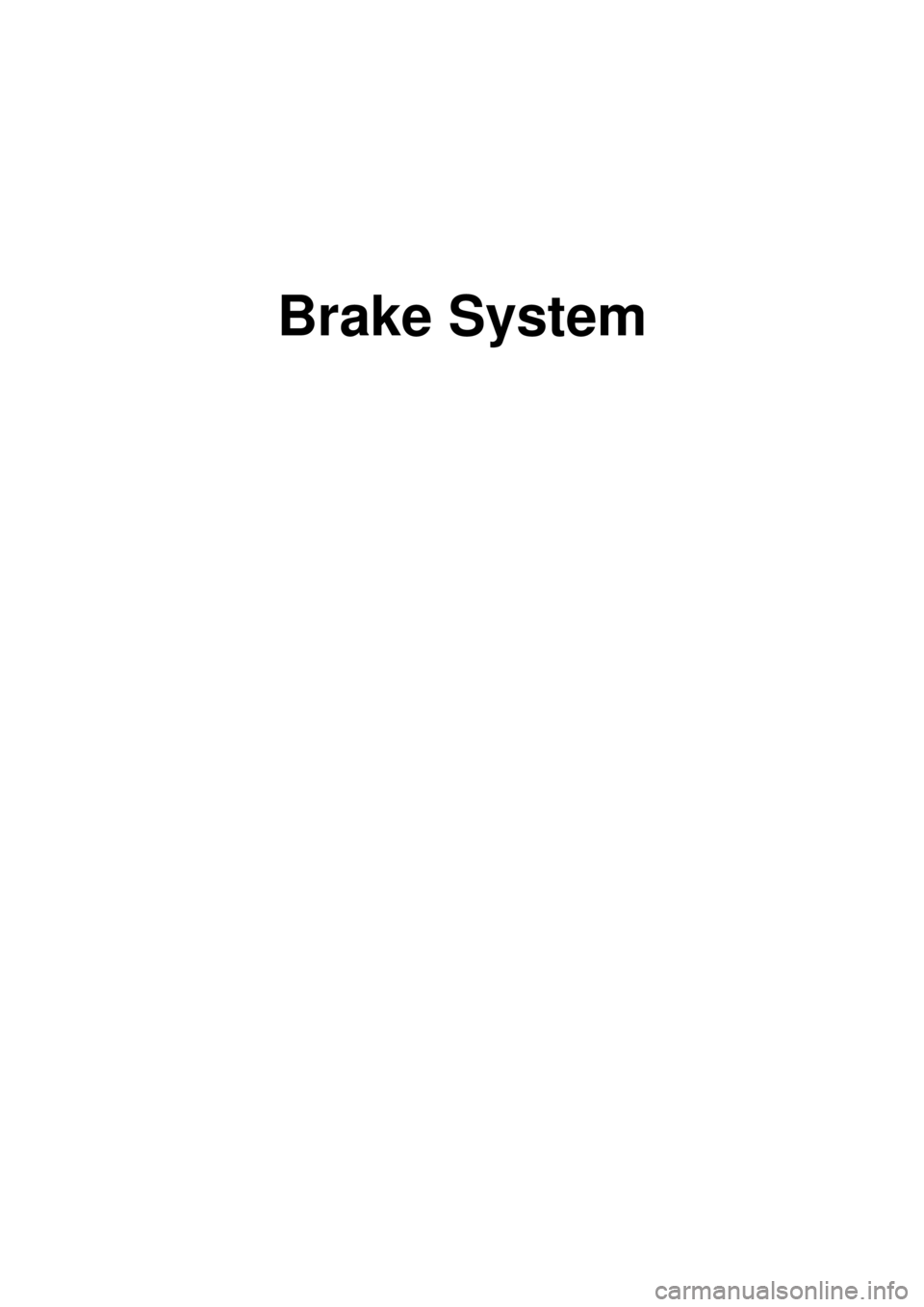
Brake System
Page 869 of 1575
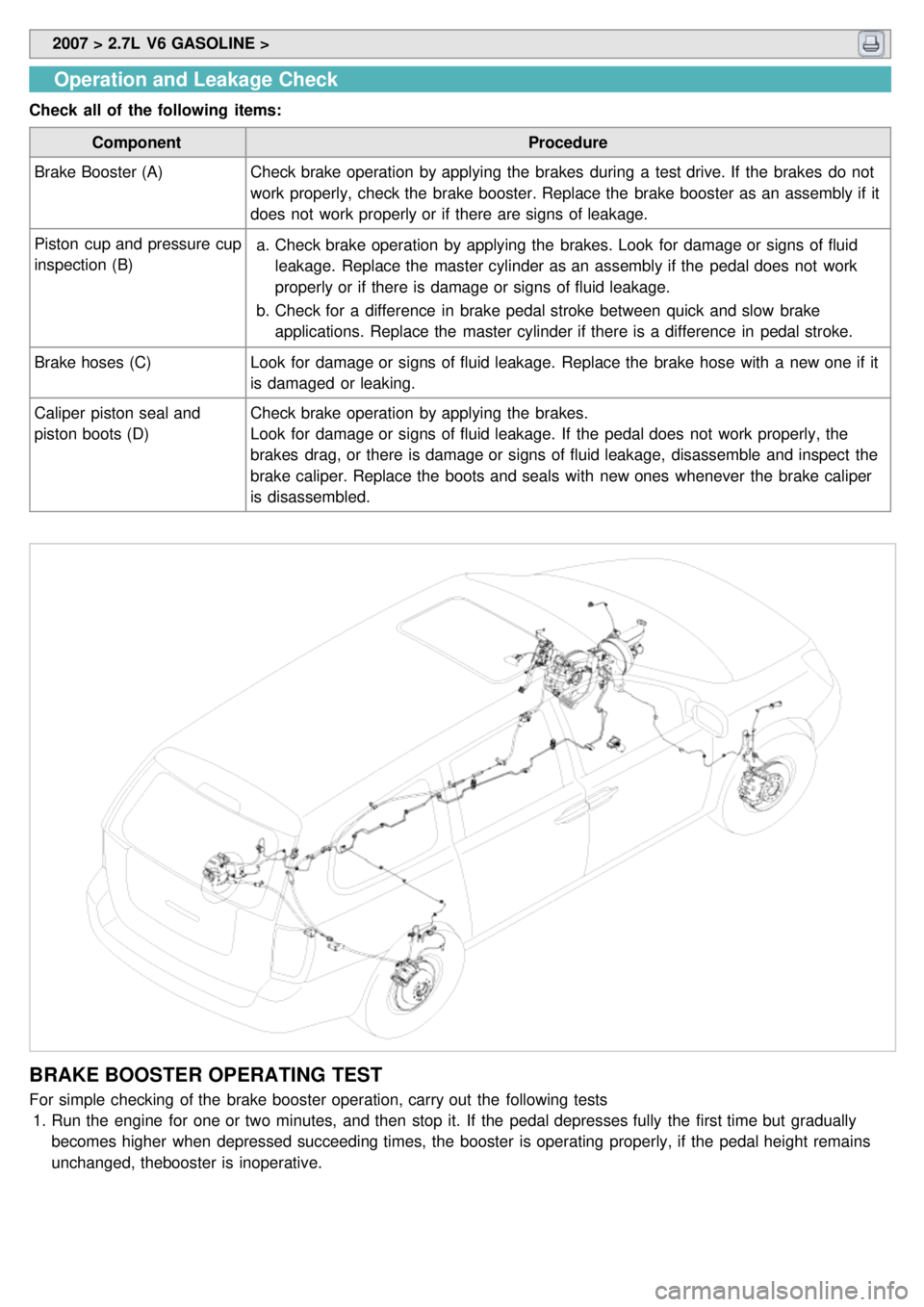
2007 > 2.7L V6 GASOLINE >
Operation and Leakage Check
Check all of the following items:
Component Procedure
Brake Booster (A) Check brake operation by applying the brakes during a test drive. If the brakes do not
work properly, check the brake booster. Replace the brake booster as an assembly if it
does not work properly or if there are signs of leakage.
Piston cup and pressure cup
inspection (B) a.
Check brake operation by applying the brakes. Look for damage or signs of fluid
leakage. Replace the master cylinder as an assembly if the pedal does not work
properly or if there is damage or signs of fluid leakage.
b. Check for a difference in brake pedal stroke between quick and slow brake
applications. Replace the master cylinder if there is a difference in pedal stroke.
Brake hoses (C) Look for damage or signs of fluid leakage. Replace the brake hose with a new one if it
is damaged or leaking.
Caliper piston seal and
piston boots (D) Check brake operation by applying the brakes.
Look for damage or signs of fluid leakage. If the pedal does not work properly, the
brakes drag, or there is damage or signs of fluid leakage, disassemble and inspect the
brake caliper. Replace the boots and seals with new ones whenever the brake caliper
is disassembled.
BRAKE BOOSTER OPERATING TEST
For simple checking of the brake booster operation, carry out the following tests
1. Run the engine for one or two minutes, and then stop it. If the pedal depresses fully the first time but gradually
becomes higher when depressed succeeding times, the booster is operating properly, if the pedal height remains
unchanged, thebooster is inoperative.
Page 870 of 1575
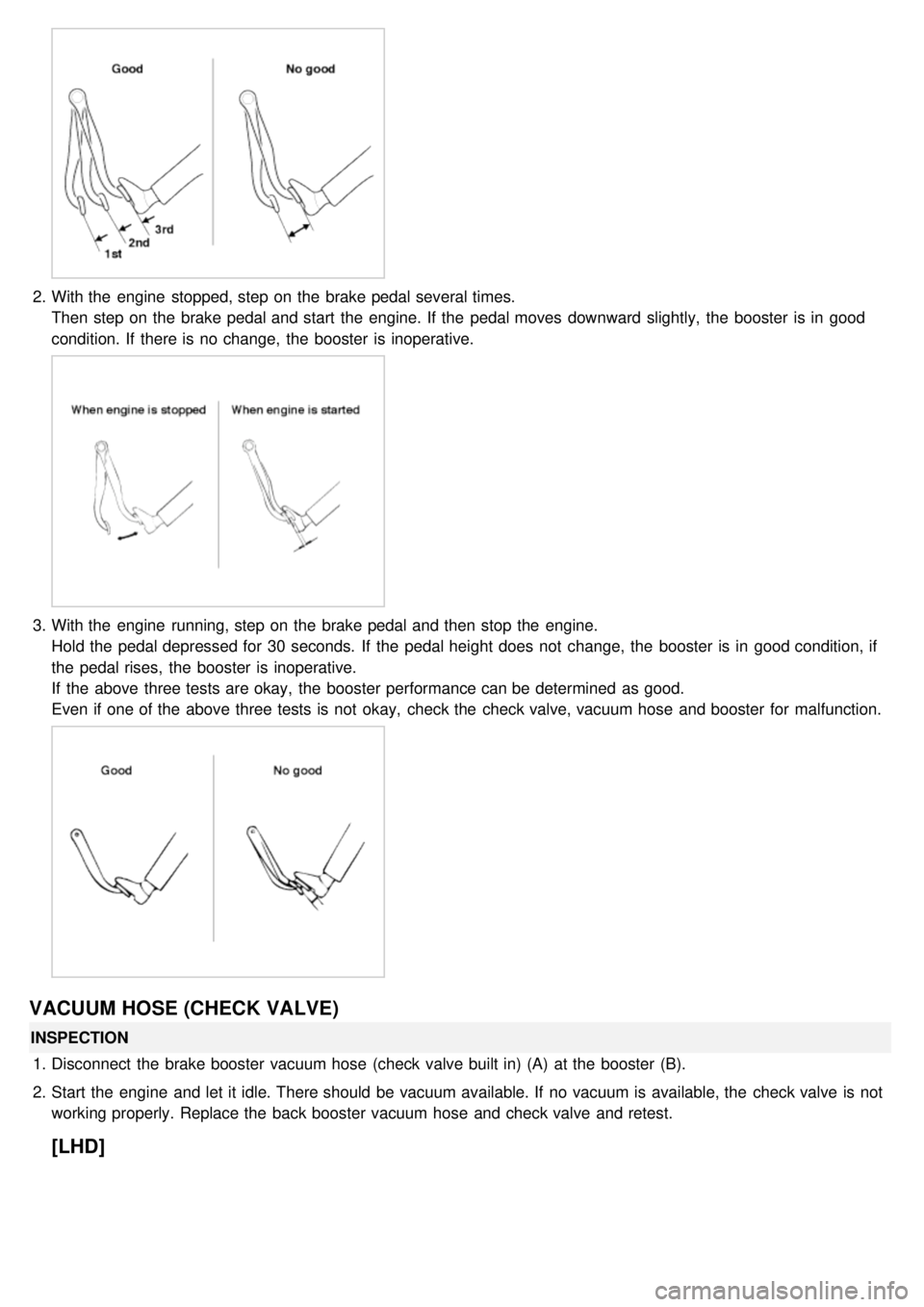
2.With the engine stopped, step on the brake pedal several times.
Then step on the brake pedal and start the engine. If the pedal moves downward slightly, the booster is in good
condition. If there is no change, the booster is inoperative.
3.With the engine running, step on the brake pedal and then stop the engine.
Hold the pedal depressed for 30 seconds. If the pedal height does not change, the booster is in good condition, if
the pedal rises, the booster is inoperative.
If the above three tests are okay, the booster performance can be determined as good.
Even if one of the above three tests is not okay, check the check valve, vacuum hose and booster for malfunction.
VACUUM HOSE (CHECK VALVE)
INSPECTION
1. Disconnect the brake booster vacuum hose (check valve built in) (A) at the booster (B).
2. Start the engine and let it idle. There should be vacuum available. If no vacuum is available, the check valve is not
working properly. Replace the back booster vacuum hose and check valve and retest.
[LHD]